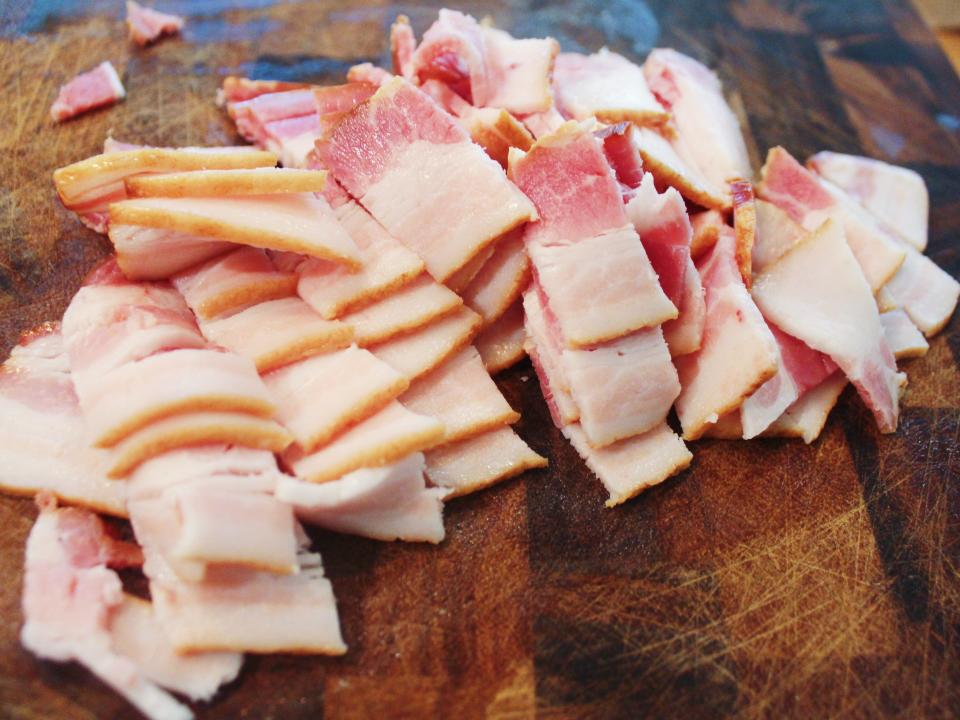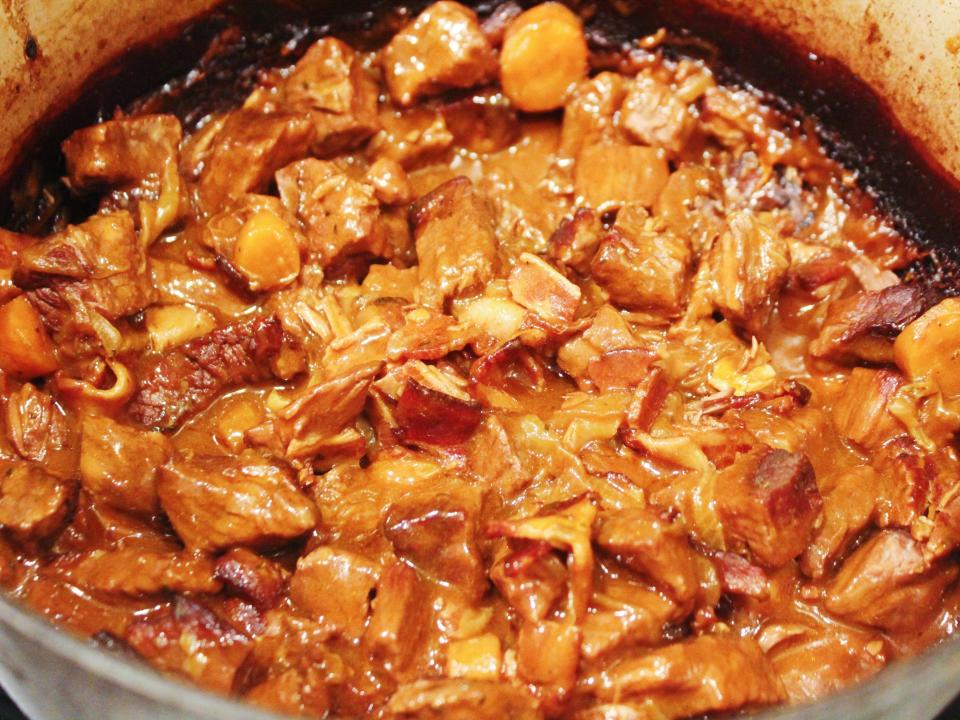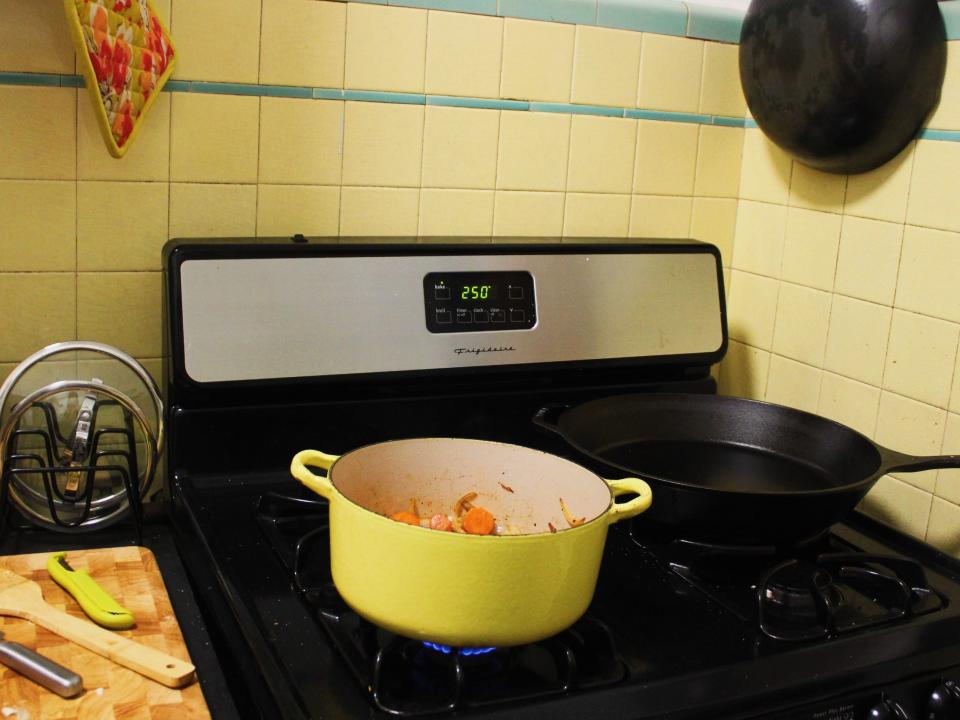I made Ina Garten's and Julia Child's beef bourguignon recipes, and I thought Child's version was more filling and flavorful
I made Ina Garten's and Julia Child's recipes for beef bourguignon to see which one I'd make again.
Ina Garten's recipe was much faster and simpler to make.
However, I preferred the taste of the recipe by Julia Child.
Despite being proud of my home-cooking skills, beef bourguignon is one recipe that has always intimidated me.
The dish takes multiple hours to prepare and is a source of stress in the movie "Julie & Julia," in which one of the characters attempts to make it for a special dinner and fails miserably.
However, despite my apprehensions, I decided to try making two versions of the famous French dish: one recipe by American celebrity chef Ina Garten and the other by Julia Child, who arguably made the dish famous.
The main difference between Garten's and Child's versions is the time it takes to prepare each dish — Child's recipe takes six hours, whereas Garten's claims to take only 1 hour and 45 minutes.
Here's how to make each beef bourguignon recipe, and which one I would make again.
I started by gathering the ingredients for Julia Child's beef bourguignon.

The ingredients were easy to find at my local grocery store, except for the bottle of full-bodied red wine. Luckily, I had a bottle of Merlot in my liquor cabinet that I thought would work nicely.
The total amount I spent on groceries was $46.81. You can find the full list of ingredients and instructions here.
The recipe takes six hours, so I got to work. I started by prepping my vegetables.

The recipe calls for one large white onion, one carrot, smashed garlic, and pearl onions. I chopped up the carrot, smashed the garlic, and cut the onion into thin slices.
The recipe also calls for bacon.

However, Child recommends preparing the bacon in an interesting way.
Rather than frying the bacon right away, the recipe requires placing it in simmering water for 10 minutes.

The reason for this step is to remove the smoky flavor that is standard with most brands of American bacon.
After straining the bacon with a slotted spoon and placing it on a paper towel to dry, I lightly browned it in my well-loved Le Creuset Dutch oven.

I then set it aside for later, and began to brown the cubes of meat in the bacon fat. It took a few minutes for the meat to become seared on all sides.
I then started sautéing the onions and carrots in the beef fat.

Once the carrots and onions had softened, I added the bacon and beef back into the pot with the vegetables, seasoned it, and sprinkled flour over the top.
At this point, Child recommends putting the pot into the oven for four minutes, tossing the contents, and putting it back in the oven.

She then recommends removing the pot from the oven and lowering the heat from 425 degrees to 325 degrees. This differs slightly from Ina Garten's recipe, which cooks at 250 degrees in the oven.
I then added in the beef stock, tomato paste, and wine.

At this step, you should also add in the smashed garlic and dried thyme. I then let the pot simmer on the stove for a few minutes.
Finally, it was time to let the oven do the work. The stew cooks in the oven for three to four hours.
In the last hour of cooking, I prepared the pearl onions and mushrooms.

To prepare the pearl onions, you'll want to sauté them in butter and oil until they're lightly browned. Then, add in a half-cup of beef stock, salt and pepper, and a herb bouquet of parsley, thyme, and a bay leaf.
The recipe said to let the onions simmer for 40 minutes until the liquid has evaporated and the onions are tender. I found it took far less time for this to happen — about 20 minutes. If I had left them any longer, they would have completely burned.
I then sautéed the mushrooms for about five minutes in a small amount of butter.

I cooked them until they were browned and slightly soft.
At the three-hour mark, I pulled the beef bourguignon out of the oven and discovered most of the liquid had evaporated.

I panicked for a second, thinking I had ruined it. Luckily, none of the stew had burned, but if I had left it much longer, it might have.
I added in another cup or two of beef stock, plus the pearl onions and the mushrooms, to try and make it more stew-like, rather than a chunky sludge of beef and vegetables. This stressed me out slightly, as dinner ended up being done way before I expected it to be.
Luckily, the extra beef stock brought it back to the correct consistency.

When making this recipe, I highly recommend checking the pot often and adding in more stock if necessary. If I hadn't checked how the dish was doing when I did, it could have ended in disaster.
The recipe says to strain the stew and simmer the remaining sauce for a few minutes in a pot on the stove. I didn't want to risk ruining the stew's consistency, so I opted out of this step. In the end, the result was delicious without doing this.
There are no words to describe just how delicious this meal was.

You can serve the beef bourguignon with boiled or mashed potatoes, cauliflower, or with a piece of bread, like I did.
The sauce was rich and flavorful, and the meat was fall-apart tender while still having a good texture. The vegetables also still had a bite to them, and I mopped up every last drop of the stew with the bread.
Next, I tried making Ina Garten's recipe for beef bourguignon.

The ingredients were easy to find at the grocery store, and some of them I already had in my kitchen.
However, upon getting the groceries home, I noticed that about a pound of the meat I had gotten had gone off the day before and was looking slightly worse for wear.
I decided to halve the recipe, which ended up being more sensible considering I was the only one eating it that night.
I spent $84.06 — considerably more than for the first recipe — on the supplies, which included a run to the liquor store to buy cognac and a bottle of dry red wine. You can find the full recipe and list of ingredients here.
I started by dicing the bacon and sautéing it in olive oil in a large Dutch-oven pot similar to the one I used for Julia Child's recipe.

Garten's recipe doesn't call for blanching the bacon, which cuts out a fair bit of time. I cooked the bacon until it was crisp and then set it aside on a plate.
I then added the beef cubes to the bacon fat and seared it on all sides.

This is the same process as Julia Child's, although I was making less meat this time around. After the meat was fully browned on all sides, I placed the pieces on the same plate as the bacon.
I then added the sliced onions and carrots to the Dutch oven.

Once the carrots and onions were lightly browned, I added two cloves of chopped garlic and continued cooking the vegetables until the garlic became fragrant.
The first major difference between the recipes arose when Garten's recipe required me to flambé cognac in the pot with the vegetables.

My kitchen in Brooklyn, New York, is quite claustrophobic and the stove doesn't even have a fan. Given the nature of my kitchen — and the fact that I had a major fire in a previous apartment — I was really anxious about igniting any kind of alcohol in the cooking process.
After consulting a few online resources and my roommate, I decided to nix the cognac and simply use more wine and beef broth instead.
I then added the meat and bacon back into the pot with the vegetables.

Despite halving the recipe, there was still a large amount of meat and vegetables — definitely enough for a few people.
I then added enough wine and beef broth to almost cover the meat, following Garten's instructions.

Next, I added the tomato paste and thyme and brought the stew to a simmer. Then, it was time to put it in the preheated 250-degree oven for the required one hour and 15 minutes.
Just before the pot was ready to be pulled from the oven, I made a butter and flour mixture in a small bowl.

Whereas Julia Child sprinkles the meat and vegetables with flour before adding in the liquid, Garten recommends adding this mixture after taking the stew out of the oven.
I also sautéed mushrooms in butter in a stainless-steel pan.

Whereas Child uses whole mushrooms, Garten says to remove the stalks before thinly slicing them.
After mixing in the butter, flour, frozen pearl onions, and mushrooms, I brought the pot to a boil on top of the stove, then lowered the heat and simmered it for another 15 minutes.

Whereas Child's beef bourguignon didn't have enough liquid when I made it, Garten's had a bit too much liquid and could have cooked off for a longer period of time.
However, the meat and vegetables were tender. According to the recipe's instructions, it was done.
Garten recommends serving the stew on top of two pieces of toasted bread.

The consistency of Garten's beef bourguignon was slightly watery compared to Child's version, but it was still really tasty. The bread was a nice addition and helped soak up some of the excess liquid, and the meat was tender.
However, I would have liked the sauce to be slightly thicker. This could have been accomplished with less liquid to start with or by leaving the stew in the oven or on the stove for longer.
Despite the work and stress that went into preparing Julia Child's beef bourguignon, it was well worth it in the end and slightly edged out Ina Garten's version.

While I really enjoyed both versions and thought Ina Garten's was much more realistic for a weeknight meal, I couldn't help but admit that I preferred the result of Julia Child's recipe.
While it took considerably more time and effort, I thought it was worth it — given that I happened to have the time and energy for it.
Some recipes are iconic for a reason.
Read the original article on Insider

 Yahoo News
Yahoo News 
